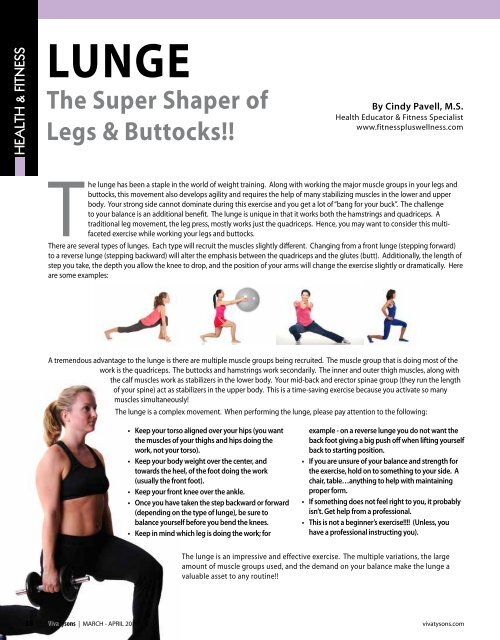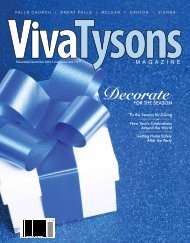March-April - Viva Tysons Magazine
March-April - Viva Tysons Magazine
March-April - Viva Tysons Magazine
You also want an ePaper? Increase the reach of your titles
YUMPU automatically turns print PDFs into web optimized ePapers that Google loves.
HEALTH & FITNESS<br />
38<br />
LUNGE<br />
The Super Shaper of<br />
Legs & Buttocks!!<br />
By Cindy Pavell, M.S.<br />
Health Educator & Fitness Specialist<br />
www.fitnesspluswellness.com<br />
The lunge has been a staple in the world of weight training. Along with working the major muscle groups in your legs and<br />
buttocks, this movement also develops agility and requires the help of many stabilizing muscles in the lower and upper<br />
body. Your strong side cannot dominate during this exercise and you get a lot of “bang for your buck”. The challenge<br />
to your balance is an additional benefit. The lunge is unique in that it works both the hamstrings and quadriceps. A<br />
traditional leg movement, the leg press, mostly works just the quadriceps. Hence, you may want to consider this multifaceted<br />
exercise while working your legs and buttocks.<br />
There are several types of lunges. Each type will recruit the muscles slightly different. Changing from a front lunge (stepping forward)<br />
to a reverse lunge (stepping backward) will alter the emphasis between the quadriceps and the glutes (butt). Additionally, the length of<br />
step you take, the depth you allow the knee to drop, and the position of your arms will change the exercise slightly or dramatically. Here<br />
are some examples:<br />
A tremendous advantage to the lunge is there are multiple muscle groups being recruited. The muscle group that is doing most of the<br />
work is the quadriceps. The buttocks and hamstrings work secondarily. The inner and outer thigh muscles, along with<br />
the calf muscles work as stabilizers in the lower body. Your mid-back and erector spinae group (they run the length<br />
of your spine) act as stabilizers in the upper body. This is a time-saving exercise because you activate so many<br />
muscles simultaneously!<br />
The lunge is a complex movement. When performing the lunge, please pay attention to the following:<br />
• Keep your torso aligned over your hips (you want<br />
the muscles of your thighs and hips doing the<br />
work, not your torso).<br />
• Keep your body weight over the center, and<br />
towards the heel, of the foot doing the work<br />
(usually the front foot).<br />
• Keep your front knee over the ankle.<br />
• Once you have taken the step backward or forward<br />
(depending on the type of lunge), be sure to<br />
balance yourself before you bend the knees.<br />
• Keep in mind which leg is doing the work; for<br />
example - on a reverse lunge you do not want the<br />
back foot giving a big push off when lifting yourself<br />
back to starting position.<br />
• if you are unsure of your balance and strength for<br />
the exercise, hold on to something to your side. A<br />
chair, table…anything to help with maintaining<br />
proper form.<br />
• if something does not feel right to you, it probably<br />
isn’t. Get help from a professional.<br />
• This is not a beginner’s exercise!!!! (unless, you<br />
have a professional instructing you).<br />
The lunge is an impressive and effective exercise. The multiple variations, the large<br />
amount of muscle groups used, and the demand on your balance make the lunge a<br />
valuable asset to any routine!!<br />
<strong>Viva</strong><strong>Tysons</strong> | MARCH - APRIL 2011 vivatysons.com




